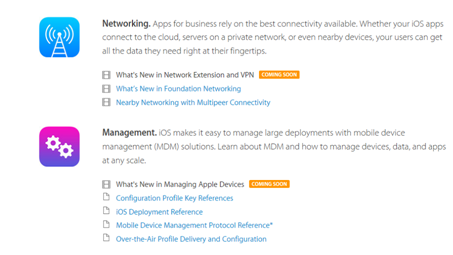Enterprise Mobility & the Connected Worker Blog
WWDC: Enterprise Recap
While the themes at WWDC were consumer oriented, there actually were some key enterprise elements.
Apple’s highly anticipated annual Worldwide Developers Conference occurred on Monday at the Moscone Center in San Francisco, California. As expected, many of the developments revolved around consumer products, namely the Apple Watch and a new music streaming service, Apple Music. However, enterprise enhancements were also present, as Apple looks to increase its presence in corporate environments.
In keeping with recent tradition, Apple announced its new operating systems: iOS 9 and OS X El Capitan, which allow for greater integration among devices. The new OS X does not include many new features, but iOS 9 provides some new improvements that enhance the competitiveness of the iPhone and iPad in both consumer and enterprise markets. The new iOS features a battery saving mode which Apple claims will add three additional hours of battery life. The company is late in incorporating this feature, which consumers clearly have been asking for - other prominent OEMs such as Samsung, Huawei and HTC have offered this capability for some time now. iPads have become more business friendly under the new operating system as new multitasking features were implemented. In particular, the new split screen feature similar to that present in Windows and some Android tablets will allow users to use separate apps simultaneously. In addition, the iPad will include a trackpad feature allowing for greater control and quick typing. These enhancements should allow for increased user-productivity, and illustrate Apple’s attempt to further outfit the iPad as a hybrid- laptop replacement similar to Microsoft’s Surface tablet.
Despite the changes mentioned above, the WWDC did not entail any significant developments or changes that will affect Apple’s overall trajectory. The new operating system for the Apple Watch and the new music streaming service may increase consumer support for Apple products; however, the innovations relating to enterprise will likely not significantly increase corporate demand. The changes to the iPad amount to Apple merely catching up to Microsoft and Samsung by incorporating a true multitasking feature. This new development takes the place of an old feature claimed by Apple to be multitasking, but in reality was more akin to app-switching. New security features, such as the addition of a six-digit passcode and the option to force enable passcodes on corporate owned devices, will certainly garner support among those in the corporate world looking to protect their corporate information from what appear to be endless data breaches. This enhancement also follows in part from Microsoft’s emphasis on security, as exemplified by Windows 10’s sophisticated containerization capabilities.
Apple has also made clear on its website that several features important to the business community will be made available in the near feature. Promised improvements in networking and device management have the ability to greatly improve business processes through increased functionality. Unfortunately, Apple does not provide any information regarding these enhancements on their website so their usefulness remains a mystery. These are critical enterprise elements to iOS 9; to date Apple has done a great job at augmenting the EMM elements of its OS, and we look forward hearing more about these key features.

A key advantage for Apple remains its App store, which for the past year has included Microsoft Office as one of its offerings. The prevalence of the App store is exemplified by the fact that 98 percent of Fortune 500 companies feature an app in the Apple App Store. Furthermore, the new spotlight search feature should allow for greater efficiency in the utilization of applications, seeing as the search results will include information present in older apps that may have been forgotten. The unification of multiple platforms working and interacting together may allow for efficiency gains as employees work more frequently outside the office. Microsoft has followed Apple’s lead in attempting to develop a similar network across devices with its new operating system, Windows 10. However, while both these companies appear to have an eye on the future, the gains of such forward thinking may be farther off as companies will need time to realize the productivity and monetary gains from such integration. In essence, the WWDC highlighted Apple’s continued efforts to cater to its strong consumer base while augmenting its enterprise feature set. Balancing consumer and enterprise demands is a challenge faced by all OEMs and begs the question- who will be the first to offer a business edition phone (a la BlackBerry)?
View the 2017 Enterprise Mobility & Connected Devices Research Outline to learn more.